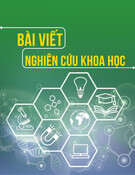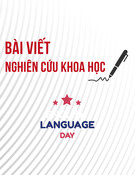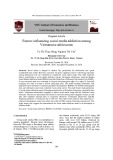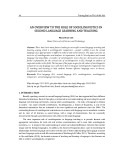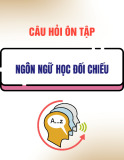
TNU Journal of Science and Technology 230(04): 13 - 21
http://jst.tnu.edu.vn 13 Email: jst@tnu.edu.vn
STUDENTS’ PERSPECTIVES AND SELF-REGULATED BEHAVIORS
TOWARD USING SOCIAL MEDIA IN LANGUAGE LEARNING
Nguyen Ha Thao Mi1, Ngo Nguyen Thien Duyen2
*
1
University of Finance – Marketing
2Ho Chi Minh City University of Economics and Finance
ARTICLE INFO ABSTRACT
Received:
02/10/2024
This paper examines Vietnamese EFL students' social media use,
language learning, and self-
regulated learning. An immersion study
with 253 A2-level non-majored
English students used mixed methods
approach to examine students' opinion on social media as a language
learning tool and its support for self-
regulated learning. The attitudes
are typically positive, considering social media for language learning
due to i
ts motivation, engagement, and convenience. More
importantly, the study shows that social media use is a precursor to
self-
regulated learning practices by students searching for resources,
practicing autonomy, and participating in online communities.
Howev
er, diversions and lack of native speaker interactions can be a
restriction, requiring discipline and creativity in social media
language acquisition. The study also suggests that educators and
researchers consider how social media can enhance and hinder
language development.
Revised:
10/02/2025
Published:
11/02/2025
KEYWORDS
Social media
Language learning
Self-regulated learning
Motivation
Engagement
QUAN ĐIỂM SINH VIÊN VÀ HÀNH VI TỰ ĐIỀU CHỈNH ĐỐI VỚI
VIỆC SỬ DỤNG PHƯƠNG TIỆN TRUYỀN THÔNG
TRÊN MẠNG XÃ HỘI TRONG VIỆC HỌC NGÔN NGỮ
Nguyễn Hà Thảo Mi
1
, Ngô Nguyễn Thiên Duyên
2*
1
Trường Đại học Tài chính – Marketing
2Trường Đại học Kinh tế - Tài chính Thành phố Hồ Chí Minh
THÔNG TIN BÀI BÁO TÓM TẮT
Ngày nhận bài:
02/10/2024
Bài báo này kh
ả
o sát
vi
ệ
c s
ử
d
ụ
ng phương ti
ệ
n truy
ề
n thông trên
mạng xã hội, học ngôn ngữ và học tự điều chỉnh của sinh viên họ
c
Tiếng Anh như ngôn ngữ nước ngoài tại Việt Nam. Một nghiên cứ
u
nhập vai với 253 sinh viên không chuyên tiếng Anh trình độ A2 đ
ã
sử dụng phương pháp hỗn hợp để khảo sát ý kiến của sinh viên về
mạng xã hội như một công cụ học ngôn ngữ và sự hỗ trợ củ
a nó cho
việc học tự điều chỉnh. Thái độ thường là tích cực, coi mạng xã hộ
i là
công cụ học ngôn ngữ do động lực, sự tham gia và tiện lợi củ
a nó.
Quan trọng hơn, nghiên cứu cho thấy việc sử dụng mạng xã hộ
i là
tiền đề cho các thực hành học tự điều chỉnh bằ
ng cách sinh viên tìm
kiếm tài nguyên, thực hành tự chủ và tham gia vào các cộng đồ
ng
trực tuyến. Tuy nhiên, sự phân tâm và thiếu tương tác với người bả
n
ngữ có thể là một hạn chế, đòi hỏi kỷ luật và sáng tạo trong việc họ
c
ngôn ngữ qua mạng xã hội. Nghiên cứu cũng gợi ý rằ
ng các nhà giáo
dục và nhà nghiên cứu nên xem xét cách mạng xã hội có thể
tăng
cường và cản trở sự phát triển ngôn ngữ.
Ngày hoàn thiệ
n:
10/02/2025
Ngày đăng:
11/02/2025
TỪ KHÓA
Mạng xã hội
Học ngôn ngữ
Học tự điều chỉnh
Động lực
Sự tham gia
DOI: https://doi.org/10.34238/tnu-jst.11209
* Corresponding author. Email: duyennnt@uef.edu.vn









